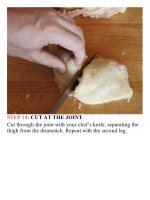The food lab better home cooking through science ( PDFDrive ) 129
Bạn đang xem bản rút gọn của tài liệu. Xem và tải ngay bản đầy đủ của tài liệu tại đây (211.95 KB, 2 trang )
FRIEDEGGS
Ifyou’relikeme,masteringfriedeggswasyourveryfirst
culinaryaccomplishment.
Or, I should say, fried eggs were my very first attempt at
accomplishing something in the kitchen, because, truth be
told, the eggs were never the same twice. This is not
necessarily a bad thing. In fact, if I’d been taking notes on
exactly how and why my eggs were never the same way
twice, I’d call that science. I’d also most likely have
developedagoodtechniqueyearsearlier.
Remember that egg whites start setting at around 155°F,
whileeggyolksstartfirmingupaslowas145°F(see“Heat
andEggs,”here).Thisgivesustherathertrickyproblemof
tryingtocooktwodifferentcomponentsofonefoodinthe
samecookingmediumatcompletelydifferentrates.It’snot
aneasytricktopulloff,butitcanbedone.
We already know one thing for sure: if you want your
eggs to be picture-perfect, the yolks standing tall, ready to
be pierced by a fork so that their golden treasure cascades
slowly across a plane of tight, clean whites, their edges
showingjustabarehintofcrispness,youhavetostartwith
thefreshest-possibleeggs.Drainingtheeggsinafine-mesh
strainerjustlikeyoudidforpoachedeggs(seehere)aidsin
achieving this result, though personally, I kinda like the
bubbly,thinwhitesthatspreadaroundthepanandbecome
extra crisp as they cook. Picture-perfect fried eggs are for
advertisements.
Atight,tallyolkisn’tjustaboutlookinggood.Withfresh
eggs, the yolks are kept elevated above the hot surface of
thepan,allowingthemtosetalittlebitmoreslowlythanthe
whites.This is key if you want your whites opaque before
youryolksgethard.
Strainingbeforefryinggetsyouapicture-perfectfriedegg.









